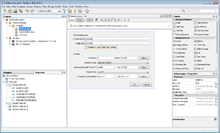NetBeans is an integrated development environment (IDE) for developing primarily with Java, but also with other languages, in particular PHP, C/C++, and HTML5. It is also an application platform framework for Java desktop applications and others.
The NetBeans IDE is written in Java and can run on Windows, OS X, Linux, Solaris and other platforms supporting a compatible JVM.
The NetBeans Platform allows applications to be developed from a set of modular software components called modules. Applications based on the NetBeans Platform (including the NetBeans IDE itself) can be extended by third party developers.
The NetBeans Team actively support the product and seek feature suggestions from the wider community. Every release is preceded by a time for Community testing and feedback
NetBeans Platform
Framework for simplifying the development of Java Swing desktop applications. The NetBeans IDE bundle for Java SE contains what is needed to start developing NetBeans plugins and NetBeans Platform based applications; no additional SDK is required.
Applications can install modules dynamically. Any application can include the Update Center module to allow users of the application to download digitally signed upgrades and new features directly into the running application. Reinstalling an upgrade or a new release does not force users to download the entire application again.
The platform offers reusable services common to desktop applications, allowing developers to focus on the logic specific to their application. Among the features of the platform are:
- User interface management (e.g. menus and toolbars)
- User settings management
- Storage management (saving and loading any kind of data)
- Window management
- Wizard framework (supports step-by-step dialogs)
- NetBeans Visual Library
- Integrated development tools
NetBeans IDE is a free, open-source, cross-platform IDE with built-in-support for Java Programming Language.
NetBeans IDE
NetBeans IDE is an open-source integrated development environment. NetBeans IDE supports development of all Java application types (Java SE (including JavaFX), Java ME, web, EJB and mobile applications) out of the box. Among other features are an Ant-based project system, Maven support, refactorings, version control (supporting CVS, Subversion, Git, Mercurial and Clearcase).
Modularity: All the functions of the IDE are provided by modules. Each module provides a well defined function, such as support for theJava language, editing, or support for the CVS versioning system, and SVN. NetBeans contains all the modules needed for Java development in a single download, allowing the user to start working immediately. Modules also allow NetBeans to be extended. New features, such as support for other programming languages, can be added by installing additional modules. For instance, Sun Studio, Sun Java Studio Enterprise, and Sun Java Studio Creator from Sun Microsystems are all based on the NetBeans IDE.
License: From July 2006 through 2007, NetBeans IDE was licensed under Sun's Common Development and Distribution License (CDDL), a license based on the Mozilla Public License (MPL). In October 2007, Sun announced that NetBeans would henceforth be offered under a dual license of the CDDL and the GPL version 2 licenses, with the GPL linking exception for GNU Classpath
Integrated modules
These modules are part of the NetBeans IDE.
NetBeans Profiler
The NetBeans Profiler is a tool for the monitoring of Java applications: It helps developers find memory leaks and optimize speed. Formerly downloaded separately, it is integrated into the core IDE since version 6.0.
The Profiler is based on a Sun Laboratories research project that was named JFluid. That research uncovered specific techniques that can be used to lower the overhead of profiling a Java application. One of those techniques is dynamic bytecode instrumentation, which is particularly useful for profiling large Java applications. Using dynamic bytecode instrumentation and additional algorithms, the NetBeans Profiler is able to obtain runtime information on applications that are too large or complex for other profilers. NetBeans also support Profiling Points that let you profile precise points of execution and measure execution time.
GUI design tool
Formerly known as project Matisse, the GUI design-tool enables developers to prototype and design Swing GUIs by dragging and positioning GUI components.[15]
The GUI builder has built-in support for JSR 295 (Beans Binding technology), but the support for JSR 296 (Swing Application Framework) was removed in 7.1.
NetBeans JavaScript editor
The NetBeans JavaScript editor provides extended support for JavaScript, Ajax, and CSS.[16][17]
JavaScript editor features comprise syntax highlighting, refactoring, code completion for native objects and functions, generation of JavaScript class skeletons, generation of Ajaxcallbacks from a template; and automatic browser compatibility checks.
CSS editor features comprise code completion for styles names, quick navigation through the navigator panel, displaying the CSS rule declaration in a List View and file structure in a Tree View, sorting the outline view by name, type or declaration order (List & Tree), creating rule declarations (Tree only), refactoring a part of a rule name (Tree only).
The NetBeans 7.4 and later uses the new [Nashorn] JavaScript engine developed by Oracle.





0 comments:
Post a Comment
Thanks for writing on us